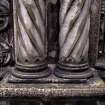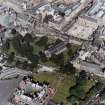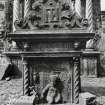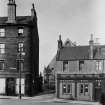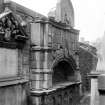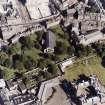Following the launch of trove.scot in February 2025 we are now planning the retiral of some of our webservices. Canmore will be switched off on 24th June 2025. Information about the closure can be found on the HES website: Retiral of HES web services | Historic Environment Scotland
Edinburgh, Candlemaker Row, Greyfriars Church, Churchyard
Burial Ground (15th Century), Churchyard (16th Century)
Site Name Edinburgh, Candlemaker Row, Greyfriars Church, Churchyard
Classification Burial Ground (15th Century), Churchyard (16th Century)
Alternative Name(s) Greyfriars Burial Ground
Canmore ID 52398
Site Number NT27SE 354.01
NGR NT 25609 73306
Datum OSGB36 - NGR
Permalink http://canmore.org.uk/site/52398
First 100 images shown. See the Collections panel (below) for a link to all digital images.
- Council Edinburgh, City Of
- Parish Edinburgh (Edinburgh, City Of)
- Former Region Lothian
- Former District City Of Edinburgh
- Former County Midlothian
NT27SE 354.01 25609 73306
NT 2562 7327. A small quantity of human bone was discovered during the excavation of a sewer pipe trench running N from the N wall of Greyfriars Kirk. The bones had been redeposited in the backfill of an earlier modern service trench, which runs E-W under the N edge of the path adjacent to the kirk building.
Sponsor: City of Edinburgh Council.
D Henderson, 1996.
NT 2557 7337 A watching brief was carried out in February 2003 during the excavation of service trenches within the churchyard of Greyfriars Tolbooth and Highland Kirk. Human skeletal remains were discovered both in disturbed contexts and in undisturbed burials cut into the subsoil. Twenty discrete groups of bones were found and the minimum number of individuals represented is 29. Coffin handles, wood fragments and nails were also recovered. A stone-built culvert was also revealed: its location and alignment suggest that it was once the main sewer leading from the church down towards Candlemaker Row. The skeletal remains will be reinterred.
Report lodged with Edinburgh SMR and the NMRS.
Sponsor: Fouin and Bell (Architects) for Greyfriars Tolbooth and Highland Kirk.
S Mitchell 2003
INVENTORY OF GRAVEYARD AND CEMETERY SITES IN SCOTLAND REFERENCE:
N.B. This reference applies collectively to NT27SE 354.01, NT27SE 354.03, NT27SE 354.05
Address: Greyfriars Church and Churchyard and Churchyard Extensions, Candlemaker Row, Edinburgh
Postcode: EH1 2QE
Status: Closed for burials but maintained
Size: Churchyard: 1.71 hectares, 4.22 acres; Churchyard extension (354.03): 0.19 hectares, 0.46 acres; Churchyard extension (354.05): 0.27 hectares, 0.68 acres
Polygon: No
TOIDs:
Number of gravestones: 590
Earliest gravestone: c1616
Most recent gravestone: c1900
Description: Burial ground associated with a church
Data Sources: OS MasterMap checked 15 September 2005; Bereavement Services Portal checked 15 September 2005; Graveyard Recording Form dated 31 October 2003
NT27SE 355 25609 73306
NMRS Print Room
Greyfriars Churchyard
2 views of monuments (1 of them duplicated) and a close view of the statue of Greyfriars Bobby at the top of Candlemaker Row
W Schomberg Scott Photograph Collection
Acc No 1997/39
REFERENCE: EDINBURGH ARCHITECTURAL ASSOCIATION LIBRARY
Manuscript re Sir George MacKenzie's tomb in Greyfriars Churchyard, Edinburgh -renovated 1893 under the superintendance of R Rowand Anderson.
REFERENCE: SCOTTISH RECORD OFFICE
Mural monument to the Mylne family. It includes: John Mylne, master mason (1611-1667); Robert Mylne of Balfargie (1633-1710) who built Mylne Court and Square, and Holyrood House; William Mylne, master mason, son of Robert (1662-1728); thomas Mylne, Deacon of Masons in Edinburgh (d.1763).
n.d. GD 1/51/107
Aikman William, artist (1682-1731). David Malloch's proposed epitaph for William Aikman's tomb in greyfriars Churchyard. Enclosed in a letter to Sir John Clerk.
1731 GD 18/4516
Tomb or monument to Sir Hugh MacCulloch of Piltoun. Instructions to his nephew that he wishes his monument to be like that of Baillie Cheisles or Dr Young and it is to bear his name, his wife's name and his armes.
1688 GD 86/739
Tombstone in Greyfriars Churchyard. Letter from Alexander McGill to the Earl of Mar. It concerns the proposed tombstone to mark Alexander Edward's grave (1651-1708).
1708 GD 124/15/938
Permission to erect a monument close to his family burial ground by the North dyke of the inner yard granted to William Little of Over Liberton. Page 73
1680 GD 122/page 25 Liberton Papers and Correspondence 1558-1793
Liberton Tomb. Estimate for repairing the monument belonging to Mr Little of Liberton amounts to ?25.17.6. Page 80
1766 GD 122/1V/no.81 Liberton Papers, Household Accounts 1702-1823
Liberton Tomb. Account for erecting an iron baluster. Thomas Sibbald, smith.
1770 GD 122/1V/no.95 Liberton Papers, Household Accounts 1702-1823
Completion of repairs to the family vault in Greyfriars Churchyard. Letter from John Aitken to W C Little. He advises him that the work is complete and requests payment. Page 75
1766 GD 122/1V/73 Liberton Papers and Correspondence 1558-1793
Report on the condition of the Little family vault in Greyfriars Churchyard. Sent by John Aitken to W C Little. Page 75
1766 GD 122/1V/72 Liberton Papers and Correspondence 1558-1793
Photographic Survey (May 1949 - July 1949)
Photographic survey of Greyfriars Churchyard, Edinburgh by the National Buildings Record Scottish Council in 1949.
Publication Account (1981)
A colony of Greyfriars, or Franciscans, dates to the summer of 1463 when there is notice .0f repairs to their place loosely stated to be 'outside the burgh' (Cowan, 1976, 131). The friars moved to a site within the burgh following the grant of land bestowed on them by James Douglas of Cassillis before 1479 when they were confirmed in their possession by James III (Cowan, 1976, 131). The friary was destroyed by the Reformers in 1559 and in 1562 the citizens petitioned the Queen for the Greyfriars yards to be used as a municipal burying ground.
In name the church survived the Reformation. By 1612, with overcrowding in the High. Church of St. Giles, the town ordered the construction of a church on the upper part of their new cemetery. The first church had an aisled nave with six bays and a western central tower. Munitions stored by the town council in the tower exploded in 1718 causing an amount of damage to the fabric of the church. This led to the construction of a second church at Greyfriars and a split congregation which
did not unite until 1929.
Information from ‘Historic Edinburgh, Canongate and Leith: The Archaeological Implications of Development’ (1981).
Conservation (2005)
Conservation treatments were carried out on both the Martry's Monument and the Duncan Ban MacIntyre Monument within Greyfriars Kirkyard in 2005. Conservation work was carried out by Graciela Ainsworth Sculpture Conservation
Conservators: Eric Waanders & Tomasina Munden
Watching Brief (17 July 2007 - 11 October 2007)
NT 2564 7326 A watching brief was undertaken between July and October 2007 during the upgrading of paths in Greyfriars Kirkyard. A small and very mixed human bone assemblage was recovered from redeposited contexts, most of it from adult males and females. An assemblage of artefacts dating from the medieval period to the 20th century was also recovered. Many of these were funerary, including coffin fittings, a shroud pin and a terracotta shield which presumably once adorned a family tomb, but there were also objects which would normally be interpreted as domestic refuse, such as pottery, bottle glass and animal bone. A photographic record of individual graves and family grave plots was also made.
Archive to be deposited with RCAHMS.
Funder: City of Edinburgh Council.
Laser Scanning (July 2022)
NT 25609 73305 In 2022, the City of Edinburgh Council and Edinburgh World Heritage (EWH), as a part of the Making Lasting Impressions Project, commissioned AOC Archaeology to create a digital record of carved monuments from the Greyfriars Kirkyard in Edinburgh.
Six monuments were selected for 3D recording. The selection criteria included the quality of carvings, architectural significance, their current condition, and potential to extract new information from the 3D data.
AOC Archaeology worked with partners, Leica Geosystems to combine the measurable record provided by terrestrial laser scanners with fine d etail a nd c olour fi delity ex tracted fr om photogrammetry data.
Once merged together, the data was meshed creating 3D geometry that was true to scale, and colour and contained fine detail needed for carvings analysis and conservation monitoring. The high-resolution models will be analysed by EWH and Friends of Greyfriars Kirkyard. The simplified m odels w ere u ploaded t o AOC’s 3D gallery on Sketchfab.
Archive: NRHE and City of Edinburgh Council HER (intended) Funder: City of Edinburgh Council and Edinburgh World Heritage
Marta Pilarska – AOC Archaeology Group
(Source: DES Volume 23)
































































































































































